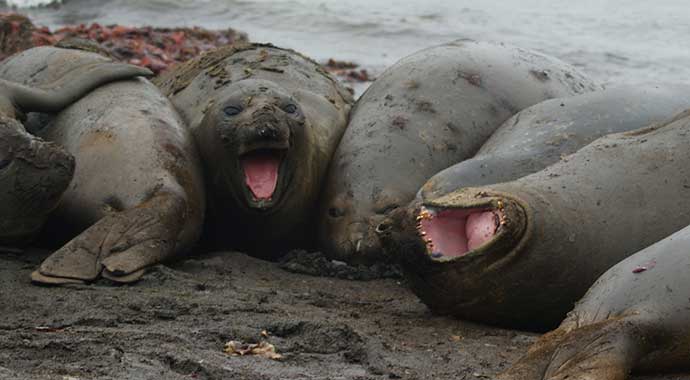Here are a few of my favourite words from nature
I love to read about nature, but every now and then, words jump out at me that make me stop in my tracks as sometimes I don’t know what they mean! Here are a few of my favourites that I’ve found over the years.
Thigmotaxis: Many animals rely on their neighbours to keep them warm or secure. Essentially thigmotaxis is the act of snuggling or cuddling to achieve this outcome. Many pinnipeds (e.g. sea lions and elephant seals) do this.
Speaking of large animals, microphagous animals are ones that feed on prey much smaller than themselves. Many animals fit this category, but some go to extremes. For example, the Humpback Whale can weigh 25 to 30 tonnes, but it feeds on krill, a tiny crustacean that might only weigh a few grams.
Eating your food requires teeth or at least a sharpened bony structure like a beak. Most animals are homodonts, where all of the teeth are of the same kind. Fish and most vertebrates typify this tooth structure. On the other hand, mammals have molars, canines and incisors to chew their food and are known as heterodonts.
 |
| Related Stories |
| A deep dive into the meaning of wacky weather terms
|
| Strange weather, stranger words to describe it
|
| Strange weather and the words we use to describe it
|
Geophagy is the act of eating dirt. Yup, you read that correctly, but why would you? In some cultures where the food is derived from the land, you can’t just go out and buy supplements, so lactating and pregnant women would often eat small quantities of mineral-rich soil to supplement their diet. Traditionally a physiological activity, geophagy has now spread to some areas as a fad. In nature, many parrots and parakeets go to ‘salt licks’ to eat the mineral-containing soils to supplement their diets.
And speaking of eating, many insects, molluscs and other invertebrates eat plants and can do so in various ways. If they prefer to bore into the wood or feed on the wood itself, they are called xylophages, and their feeding style is correspondingly known as xylophagous feeding.
Afraid of pigeons? Well, there’s a name for that – peristerophobia, which, apparently, stems from an irrational fear of risk from pigeon feces. In keeping with this, perhaps, is orthogenic, meaning derived from birds. Often this word is coupled with the word ‘soil’; thus, ornithogenic soil is a mixture of bird feces, feathers, food waste and body parts. This is essentially the only true ‘soil’ in Antarctica.
Ever notice the distinctive odour typified as that earthy smell that arises after a rain storm? It’s called petrichor and is derived from the Greek meaning “originating from stone”. Petrichor is a modern word, reportedly first coined by Australian scientists in 1964 to describe this pleasant and distinctive odour.
Speaking of rain, ombrophobous refers to the avoidance of rain in plants, but, more specifically, the fact that many plants can’t withstand intense or prolonged rain events. The opposite of this is ombrophilous, or rain loving. Cacti would be an example of ombrophobic plants, while many ferns would be ombrophilic. Many plants are part of a broader plant community, but some don’t like company at all – so a consociation is a plant community comprised of a single primary species. For example, we might have a Beech forest where almost all the trees are of this one species.
In closing, let’s explore some weather and climate-related words.
- Cryoturbation is a well-known phenomenon whereby the power of ice crystals can shatter the structure of rocks; this is typified by the rocks breaking and cracking from the constant thawing and freezing. Even large rocks will be affected.
- Cryosols are perennially frozen organic and mineral soils, such as one might find in parts of the snow-free parts of Antarctica.
- Continentality is a descriptor for areas not near large bodies of water, such as oceans. Typically, coastal areas do not experience the seasonal extremes in temperature that inland sites do, but places located in the middle of the continent experience continentality and can have very cold winters and hot summers.
- We all know about the Richter scale, which measures the energy released in an earthquake, but did you know that the Mercalli scale measures the intensity of the quake?
Okay, that’s enough, methinks! Gotta go find a polyandrous sandpiper or maybe check out a polynya in the Arctic.
Geoff Carpentier is a published author, expedition guide and environmental consultant. Visit Geoff on LinkedIn, Instagram and Facebook.
For interview requests, click here.
The opinions expressed by our columnists and contributors are theirs alone and do not inherently or expressly reflect the views of our publication.
© Troy Media
Troy Media is an editorial content provider to media outlets and its own hosted community news outlets across Canada.


